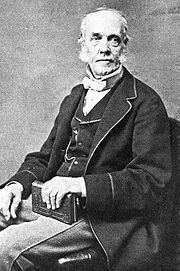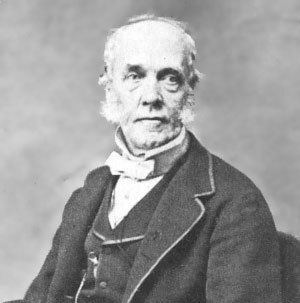Name William Lassell | Spouse Maria King (m. 1827) Role Merchant | |
 | ||
Born 18 June 1799Bolton, England ( 1799-06-18 ) | ||
William Lassell, (18 June 1799 – 5 October 1880) was an English merchant and astronomer. He is remembered for his improvements to the reflecting telescope and his ensuing discoveries of four planetary satellites.

Life

William Lassell was born in Bolton, Lancashire, a town west of Manchester. He was educated first in Bolton then at Rochdale Academy. After the death of his father, he was apprenticed from 1814 to 1821 to a merchant in Liverpool. He then made his fortune as a beer brewer, which enabled him to indulge his interest in astronomy. He built an observatory at his house "Starfield" in West Derby, a suburb of Liverpool. There he had a 24-inch (610 mm) reflector telescope, for which he pioneered the use of an equatorial mount for easy tracking of objects as the Earth rotates. He ground and polished the mirror himself, using equipment he constructed. The observatory was later (1854) moved further out of Liverpool, to Bradstone.

In 1846 Lassell discovered Triton, the largest moon of Neptune, just 17 days after the discovery of Neptune itself by German astronomer Johann Gottfried Galle. In 1848 he independently co-discovered Hyperion, a moon of Saturn. In 1851 he discovered Ariel and Umbriel, two moons of Uranus.
When Queen Victoria visited Liverpool in 1851, Lassell was the only local she specifically requested to meet.
In 1855, he built a 48-inch (1,200 mm) telescope, which he installed in Malta because of the observing conditions that were better than in often-overcast England. On his return to the UK after several years in Malta he moved to Maidenhead and operated his 24-inch (610 mm) telescope in an observatory there. The 48-inch telescope was dismantled and was eventually scrapped.
Lassell was a Fellow of the Royal Astronomical Society (FRAS) from 1839, won the Gold Medal of the Royal Astronomical Society in 1849, and served as its president for two years starting in 1870. He was elected a Fellow of the Royal Society (FRS) in 1849 and won their Royal Medal in 1858. Lassel was also a Fellow of the Royal Society of Literature (FRSL). He was furthermore elected an honorary Fellow of the Royal Society of Edinburgh (HonFRSE) and of the Society of Sciences of Upsala, and received an honorary LL.D. degree from the University of Cambridge in 1874.
Lassell died in Maidenhead in 1880. Upon his death, he left a fortune of £80,000 (roughly equivalent to £7,200,000 in 2015). His telescope was presented to the Royal Observatory in Greenwich.
The crater Lassell on the Moon, a crater on Mars, the asteroid 2636 Lassell and a ring of Neptune are named in his honour.
